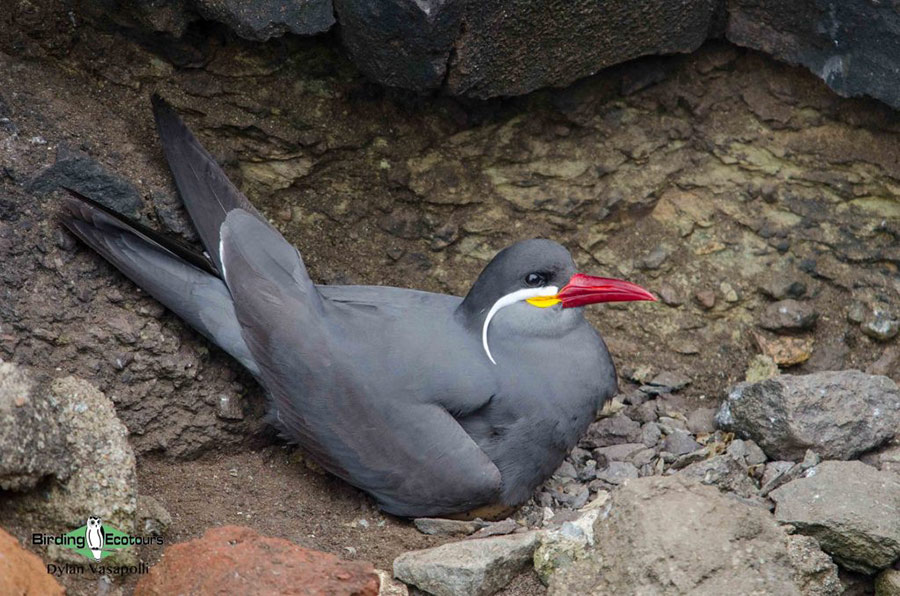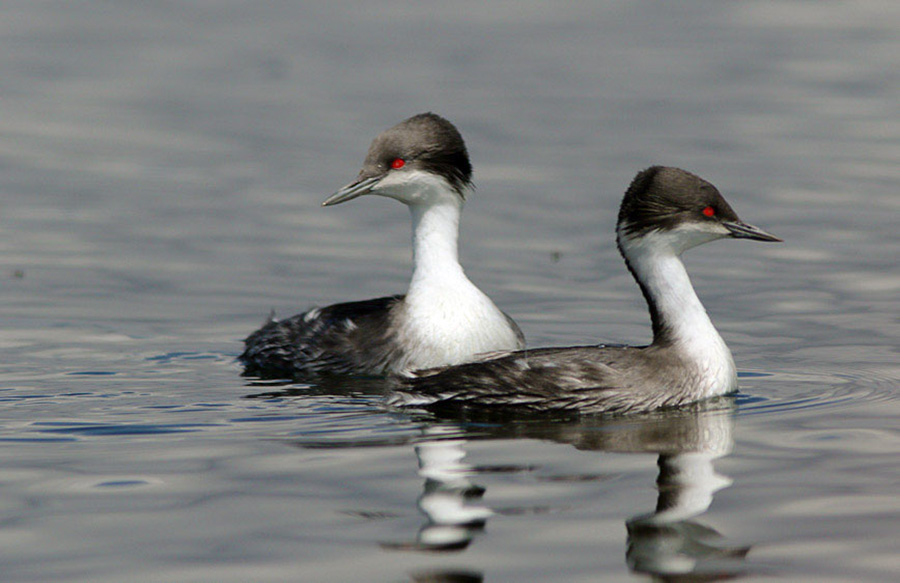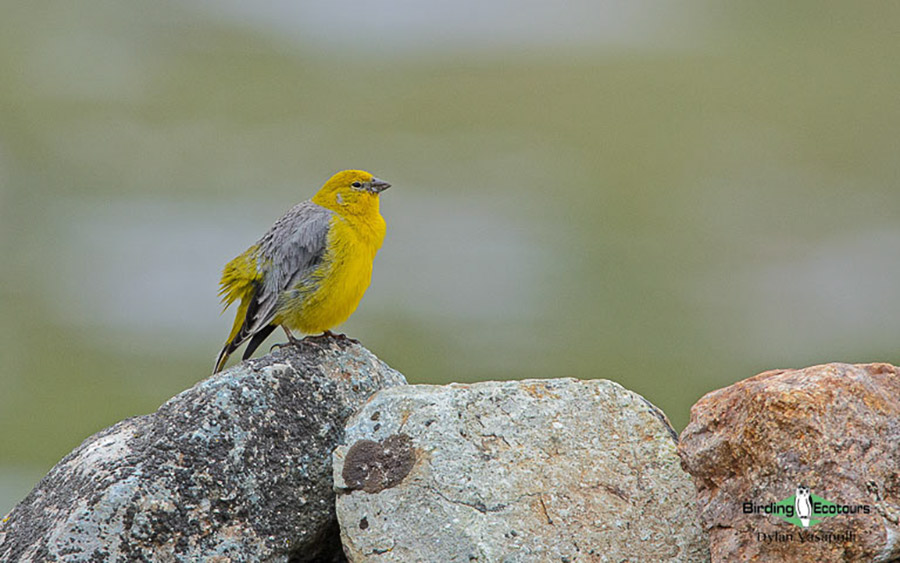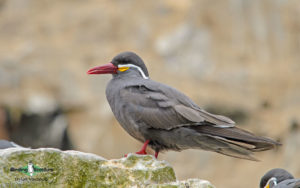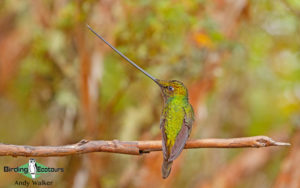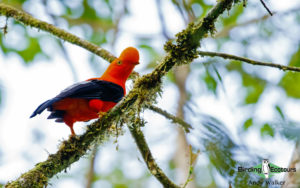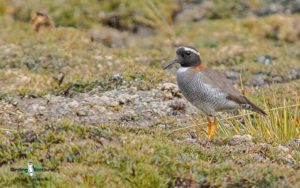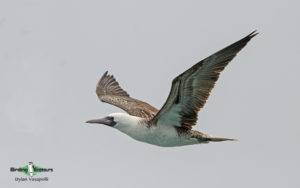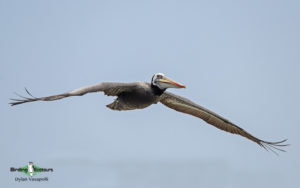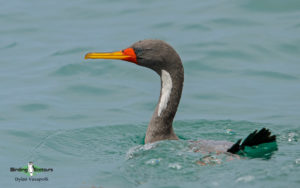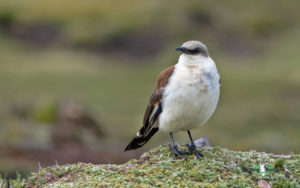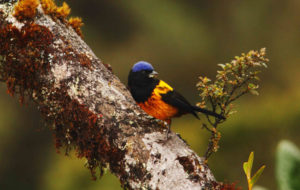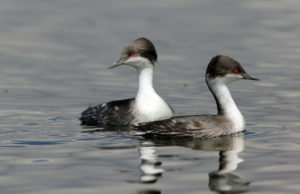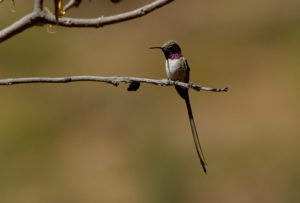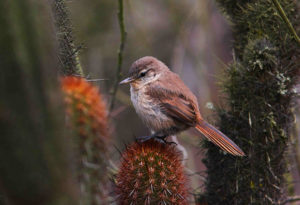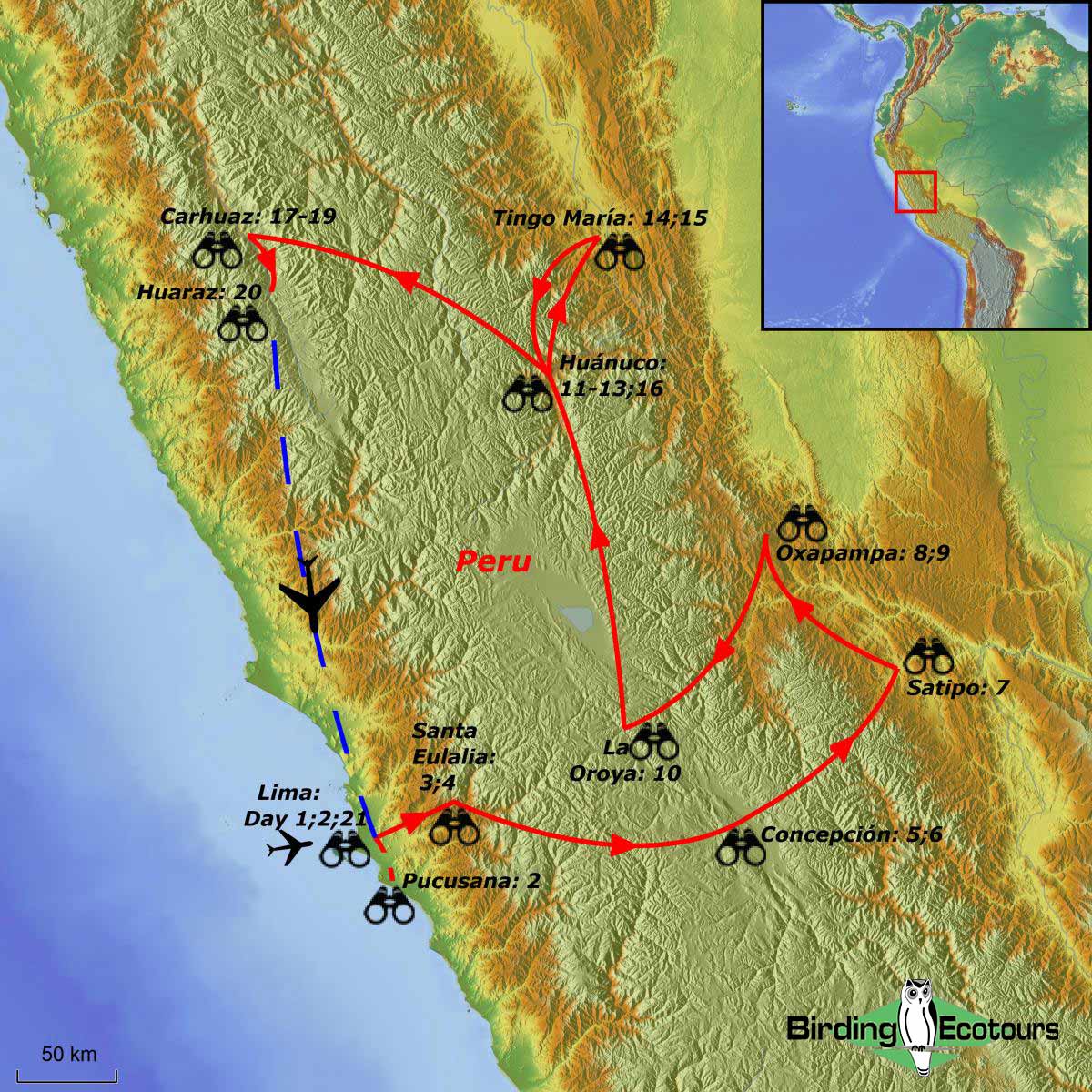Birding Tour Peru: Central Peru
Go to: Peru Birding Tours | Birding Tours in the Neotropics | All our birding tours
Central Peru Birding Adventure
August 2025
The Central Andes of Peru is one of the least known birding routes in South America, and this is completely unjustified.
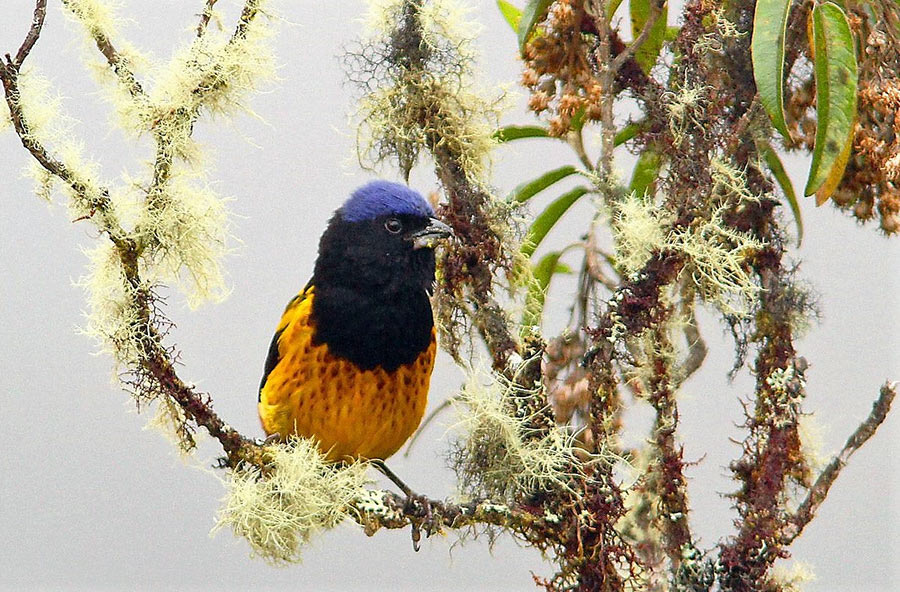 Golden-backed Mountain Tanager is one of our special targets on this trip (photo Alejandro Tello).
Golden-backed Mountain Tanager is one of our special targets on this trip (photo Alejandro Tello).
Our magnificent tour is designed to take you across the central Andes of Peru, visiting different habitats and ecosystems at varying elevations providing diverse sets of unique avian species, including several country endemics not found anywhere else. We start the trip by visiting the coast of Lima, exploring the cold waters of the Humboldt Current and habitats on the western slopes of the Andes, such as freshwater lagoons, the dry Pacific desert, the unique Peruvian lomas (areas of fog-watered vegetation in the coastal desert), the dry inter-Andean valleys, and the high-elevation mountains at the base of the mighty, snow-capped Central Andes. We will also visit the endangered Polylepis forest, which holds several sought-after Andean species. We then descend the eastern slopes of the Andes, where we explore elfin forest, like páramos, lush cloudforest and upper Amazon forest.
Perhaps the prettiest tern in the world, Inca Tern.
This birding and overlanding trip will take three weeks in total, and we could see species such as Inca Tern, Humboldt Penguin, Peruvian Thick-knee, Peruvian Pipit, Thick-billed Miner, Andean Tinamou, Great Inca Finch, White-capped Dipper, Torrent Duck, Andean Condor, Least, Grey-breasted, and Rufous-bellied Seedsnipes, White-bellied Cinclodes, Diademed Sandpiper-Plover, Andean Flicker, Junin Grebe, Black Rail (the endemic subspecies, often referred to as ‘Junin Rail’), Andean Avocet, Puna Plover, Andean Cock-of-the-rock, Blue-banded Toucanet, Peruvian Wren, and Crimson-mantled Woodpecker. In addition, we might find Bay Antpitta, Masked Fruiteater, Chestnut-crested Cotinga, White-eared Solitaire, Cloudforest Screech Owl, Oilbird, Bay Antpitta, Stripe-headed Antpitta, Rufous Antpitta, Rufous-vented Tapaculo, White-cheeked Cotinga, Bay-vented Cotinga, Blue-headed Macaw, and many more.
We should get views of the most-wanted Diademed Sandpiper-plover.
This trip is particularly good for certain special tanagers, such as the endemic Golden-backed Mountain Tanager, the endemic Yellow-scarfed Tanager, the endemic Huallaga Tanager, the endemic Brown-flanked Tanager, and other attractive species like Grass-green Tanager, Golden-collared Tanager, Scarlet-bellied Mountain Tanager, and Yellow-throated Tanager.
During our trip we will look for incredible high-elevation hummingbird species, like the endemic Black-breasted Hillstar, Olivaceous Thornbill, Coppery Metaltail, Sword-billed Hummingbird, Giant Hummingbird, Oasis Hummingbird, Peruvian Sheartail, Bronze-tailed Comet, and Blue-mantled Thornbill.
We invite you to join us in exploring this incredible birding route in Peru!
Itinerary
Day 1. Arrival
You will arrive at the Jorge Chávez International Airport in Lima and be transferred to your hotel. No activities are planned for day 1, since most international flights arrive in Lima late in the evening. If you arrive on an early flight, the hotel might charge you an extra accommodation fee for an early check-in, alternatively, we can organize an additional birding morning near the city for you.
Overnight: Hotel in Lima
Day 2. Pucusana beach, Puerto Viejo beach, and transfer to Asia Beach
We will start by visiting the fishing village of Pucusana, 37 miles (60 kilometers) south of the city. Here we will have a chance to see many coastal birds and Humboldt Current specials like Inca Tern, Belcher’s Gull, Peruvian Pelican, and Peruvian Booby. We could also see Guanay Cormorant, Red-legged Cormorant, Blackish Oystercatcher, Humboldt Penguin, and the endemic Peruvian Seaside Cinclodes. Later we will drive to Puerto Viejo beach, where we will look for Great Grebe, Andean Coot, Cinnamon Teal, White-cheeked Pintail, Peruvian Meadowlark, Many-colored Rush Tyrant, Wren-like Rushbird, Grassland Yellow Finch, Grey-hooded Gull, American Oystercatcher, Grey Gull, Peruvian Thick-knee, and the endemic Coastal Miner. We will transfer to a modern Asia Beach resort for an overnight.
Overnight: Asia Beach
Day 3. Lomas de Asia and transfer to Santa Eulalia
The Lomas de Asia municipal reserve has recently been opened to tourism and is closer to Lima than the well-known Lomas de Lachay National Reserve, both protect the same lomas costeras ecosystem. The lomas result from a combination of coastal climatic factors and peculiar geography which produces heavy clouds, fog and mist in an almost rainless desert. Mist rolls in from the nearby Pacific and moisture condenses when it reaches the Andes. The drizzle, fog and mist are most common in the humid season (approximately June to November), and supports abundant flora and fauna in the region. The Lomas de Asia are very good for the endemic Thick-billed Miner, Oasis Hummingbird, Peruvian Sheartail, Greyish Miner, Short-tailed Field Tyrant, Collared Warbling Finch, Band-tailed Sierra Finch and, hopefully, the endemic but nomadic Raimondi Yellow Finch. After lunch we will drive back to Lima and from there toward the eastern part of the Andes, where we will spend a night in the Santa Eulalia Valley.
Overnight: Santa Eulalia
Day 4. Santa Eulalia road
Today we will have an early start to explore the Santa Eulalia road and the upper canyon. This fantastic location in the highlands of Lima provides a beautiful complex of scenery, surrounded by the Andes and dominated by blue skies. We will drive over two hours up the mountains to reach the habitat of the endemic, shy, rare, and localized Rufous-breasted Warbling Finch. We will focus all our efforts looking for this tricky fellow, but in the same area we could have views of Canyon Canastero and several Peruvian endemics such as Black-necked Woodpecker, Bronze-tailed Comet, Rusty-bellied Brushfinch, Rusty-crowned Tit-Spinetail, and Great Inca Finch. Other juicy birds include Giant Hummingbird, Sparkling Violetear, Pied-crested Tit-Tyrant, Tufted Tit-Tyrant, Mourning Sierra Finch, Streak-throated Bush Tyrant, Blue-and-yellow Tanager, Black-chested Buzzard-Eagle, Aplomado Falcon, Torrent Duck, White-capped Dipper, Peruvian Pygmy Owl, Greenish Yellow Finch, and Bare-faced Ground Dove, and we might find the majestic Andean Condor.
Overnight: Santa Eulalia
Day 5. Marcapomacocha and transfer to La Merced
Today we should have great fun exploring Marcapomacocha. This is high in the Andes at almost 15,000 feet (4,500 meters) and, with care and adhering to guidelines for preventing altitude sickness, we should not experience any problems. This birding location is world famous for holding the legendary Diademed Sandpiper-Plover, and we will also be looking for some Peruvian endemics like Black-breasted Hillstar, Junin Canastero, Dark-winged Miner, and the rare, localized, and endemic White-bellied Cinclodes, listed as Critically Endangered (IUCN). Other birds here include Andean Lapwing, Andean Goose, Crested Duck, Variable Hawk, Puna Ibis, Giant Coot, Puna Teal, White-winged Diuca Finch, Black Siskin, Olivaceous Thornbill, Plain-breasted Earthcreeper, Streak-throated Canastero, Grey-breasted Seedsnipe, and Puna Snipe, and, hopefully, Rufous-bellied Seedsnipe.
Later we will drive to Concepción.
Overnight: La Merced
Day 6. La Merced and drive to Oxapampa
Today we will explore the tropical foothills of La Merced, where some of the targets will be the endemic Cerulean-capped Manakin and Creamy-bellied Antwren, among many other species. Then we will start the long drive to Oxapampa. We will arrive at our comfortable lodge in Oxapampa before dusk, where our host will be waiting for us with a tasty dinner. If the weather permits and spirits are still high, this will be our first chance to look for the poorly known Cloudforest Screech Owl,one of the main targets at this lodge.
Overnight: Ulcumano Ecolodge, Oxapampa
Day 7. Full day at Ulcumano Ecolodge
Today we will have a nice day birding around the lodge grounds. Our main targets here are the endemic Bay Antpitta, the endemic Masked Fruiteater, the endemic Rufous-vented Tapaculo, the most-wanted Chestnut-crested Cotinga, White-eared Solitaire and, hopefully, Brown Tinamou. At dusk we will look for the Cloudforest Screech Owl again.
Overnight: Ulcumano Ecolodge, Oxapampa
Day 8. Birding around Ulcumano and transfer to La Oroya
We can give the Cloudforest Screech Owl one more attempt before dawn (in case we need it) and then leave the lodge, exploring coffee plantations for the endemic Creamy-bellied Antwren. It will be a long drive back to the high Andes, to the bustling town of La Oroya. On the way we might find Mountain Caracara and Andean Ibis.
Overnight: Hotel El Dorado, La Oroya
The flightless Junin Grebe; our primary target at Lake Junín (photo Alejandro Tello).
Day 9. Lake Junín and transfer to Huánuco
Today we will explore Lake Junín (13,395 feet / 4,080 meters elevation) in search of the endemic, Critically Endangered (IUCN), and flightless Junin Grebe, one of the scarcest birds in Peru. Other birds at the lake include Andean Avocet, Puna Plover, Chilean Flamingo, Yellow-billed Teal, Puna Teal, Yellow-billed Pintail, Cinnamon Teal, Andean Duck, Cinereous Harrier, and Andean Gull. One of our major targets is the endemic and distinctive subspecies of Black Rail, which is sometimes treated as a different species called ‘Junin Rail’. In addition, the rocky and dry shores around the lake are good for the endemic Dark-winged Miner and Black-breasted Hillstar, Black Siskin, Black-billed Shrike-Tyrant, and Andean Flicker. Then we will drive across the Junín plains, also known as the Pampas de Junín, and descend to Huánuco. On the way we should see Vicuña, the national animal of Peru and featured on the Peruvian coat of arms.
Overnight: Grand Hotel Huánuco, Huánuco
Day 10. Bosque Unchog
Today we will visit the remote elfin and humid forest of Bosque Unchog in the mountains above Huánuco. This place is known to hold some of the most sought-after endemics in the Andes like the incredible Golden-backed Mountain Tanager, Bay-vented Cotinga, Pardusco, Rufous-browed Hemispingus, Brown-flanked Tanager, and Coppery Metaltail. After a full day birding, we will return to Huánuco in the afternoon.
Overnight: Grand Hotel Huánuco, Huánuco
Day 11. Bosque Unchog
This will be another full day to explore the Bosque Unchog forest, looking for the species described above and, in addition, we will look for Line-fronted Canastero, White-chinned Thistletail, Golden-collared Tanager, the endemic Yellow-scarfed Tanager, White-collared Jay, Red-rumped Bush Tyrant, the endemic Neblina Tapaculo, and Red-crested Cotinga. We will return to Huánuco late in the afternoon.
Overnight: Grand Hotel Huánuco, Huánuco
Day 12. Tingo Maria and the Oilbird cave
Today we will drive toward the eastern lowlands of Tingo Maria. On the way, we might stop along the Carpish Mountains if we see some good mixed flocks, as we have found on previous trips. Unfortunately, there is a lot of habitat destruction and access to the site from the road is difficult. The place is not as attractive as it used to be. On the way to Tingo Maria we might see Crested Oropendola, Russet-backed Oropendola, Magpie Tanager, Blue-headed Parrot, and even Fasciated Tiger Heron and Andean Cock-of-the rock. One of the main attractions of Tingo Maria is the famous Oilbird cave, where we could see many of these strange-looking birds. The Tingo Maria lowlands are also good for Blue-headed Macaw, another of our targets. Some classic lowland species are always present, such as Great and Lesser Kiskadee, White-eyed Parakeet, Cliff Flycatcher, Common Tody-Flycatcher, Rufous-breasted Hermit, Yellow-throated Toucan, Green-backed Trogon, and the endemic Huallaga Tanager. At night we will try for Tropical Screech Owl and Band-bellied Owl around our lodge.
Overnight: Villa Jennifer Farm & Lodge, Tingo Maria
Day 13. Full day at Villa Jennifer Farm & Lodge
After breakfast we will explore the grounds of Villa Jennifer, where we can see a good set of species, like Yellow-tufted Woodpecker, Lineated Woodpecker, Cream-colored Woodpecker, Blue-crowned Trogon, Olivaceous Woodcreeper, Plumbeous Kite, Spot-winged Antbird, Grey-crowned Flatbill, Yellow-throated Toucan, Golden-collared Toucanet, Chestnut-eared Aracari, Amazonian Motmot, and Lafresnaye’s Piculet. In addition, we could have good views of Gilded Barbet, Bluish-fronted Jacamar, Yellow-olive Flatbill, Mouse-colored Tyrannulet, Rufous-fronted Tody-Flycatcher, Limpkin, Capped Heron, Crested Oropendola, Blue-headed and Military Macaws, Reddish Hermit, Golden-tailed Sapphire, Grey-breasted Sabrewing, Masked Tityra, Pale-legged Hornero, Dark-breasted Spinetail, Thrush-like Wren, and Ferruginous Pygmy Owl.
Overnight Villa Jennifer Farm & Lodge, Tingo Maria
Cream-colored Woodpecker can be seen in the grounds of Villa Jennifer.
Day 14. Transfer to Huánuco
After a last morning birding around Tingo Maria we will have an easy transfer back to Huánuco.
Overnight: Grand Hotel Huánuco, Huánuco
Day 15. Drive to Carhuaz
Today we will have a long drive via the La Union mountain pass to Huaraz in the heart of the Cordillera Blanca. On the way we will look for classic Andean species like Andean Lapwing, Andean Flicker, Andean Negrito, Bright-rumped Yellow Finch, Peruvian Sierra Finch, Puna Ibis, Andean Ibis, Rufous-bellied Seedsnipe, and Grey-breasted Seedsnipe.
Overnight: Hotel El Abuelo, Carhuaz
Bright-rumped Yellow Finch – a high-altitude special.
Days 16 – 17. Huascarán National Park
We will have two full days at Huascarán National Park, a UNESCO World Heritage site, which comprises most of the Cordillera Blanca, the world’s highest tropical mountain range. Here we will look for the amazing species which occur in the Polylepis forest between the Llanganuco Lakes, including Ash-breasted Tit-Tyrant, Tawny Tit-Spinetail, the spectacular, endemic White-cheeked Cotinga, the endemic Ancash Tapaculo, the sought-after Giant Conebill, and Tit-like Dacnis. In addition, we may find the endemic Plain-tailed Warbling Finch, the endemic Striated Earthcreeper, the endemic Rufous-eared Brushfinch, and Stripe-headed Antpitta.
Overnight: Hotel El Abuelo, Carhuaz
Day 18. Birding the Huaylas road and the Pueblo Libre
On the last birding day of the tour, we will spend the morning exploring the Huaylas road looking for the endemic Rufous-backed Inca Finch, and the dry slopes of the Pueblo Libre area for the endemic Pale-tailed Canastero. Later we will transfer to Huaraz and check into our comfortable hotel.
Overnight: Andino Club Hotel, Huaraz
Day 19. Drive back to Lima with birding en route
We will have an early start as we leave the city of Huaraz and make our way to the coast at Lima. Along the route we will make strategic stops, looking for high elevation species at Lake Conococha where we might get a few new species for our already substantial list. When we reach the coast, we will visit other areas to look for Wilson’s Plover, Great Grebe, Peruvian Thick-knee, Peruvian Tern, Cabot’s Tern, White-cheeked Pintail and many other new birds. There will also be opportunities to improve waterfowl photography today. We will arrive in Lima late in the afternoon and check into our hotel and, of course, enjoy a tasty dinner to celebrate a great trip.
Overnight: Hotel in Lima
Day 20. Departure
Tour participants will be transferred to Lima’s Jorge Chávez International Airport today to catch international flights home.
Please note that the itinerary cannot be guaranteed as it is only a rough guide and can be changed (usually slightly) due to factors such as availability of accommodation, updated information on the state of accommodation, roads, or birding sites, the discretion of the guides and other factors. In addition, we sometimes have to use a different international guide from the one advertised due to tour scheduling.
Download Itinerary
Central Peru Trip Report, September 2019
14-28 September 2019
By Eduardo Ormaeche
DOWNLOAD TRIP REPORT
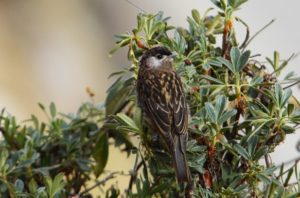
Overview
Our group for this tour had done a Comprehensive Northern Peru tour with us some years ago, which included the beautiful Cordillera Blanca and the Polylepis forest at the base of the Huascarán mountain, so they asked us to do a shorter version of our 21-day trip, deleting the third week.
Nevertheless our Central Peru tour 2019 was one of the most enjoyable trips I have ever led along this great birding route. Perhaps this would not be the ideal destination for the less adventurous birder, as the trip is a fabulous, long drive across four Peruvian states, providing the opportunity to explore the most mega-diverse habitats in the country, such as the Pacific shores along the coast of Lima, the dry inter-Andean valleys, the high Andes with their respective ecosystems including bog cushion habitats at the base of the snow-capped mountains, Polylepis forest, high plateaus covered by tussocks like the Junín Altiplano, elfin Andean forest, cloudforest mountains, and upper-tropical mountains where the Andes meet the Amazon. We can translate this description of habitats into a great set of endemics and range-restricted species.
On this trip we saw some classic South American and most-wanted species such as Torrent Duck, Andean Condor, Andean Cock-of-the rock, Hoatzin, Giant Hummingbird, Sword-billed Hummingbird, Sunbittern, and Golden-headed Quetzal as well as a large number of exquisite endemic and range-restricted species such as Great Inca Finch, Rufous-breasted Warbling Finch, White-bellied Cinclodes, Diademed Sandpiper-Plover, Junin Grebe, White-cheeked Cotinga, Chestnut-crested Cotinga, Bay-vented Cotinga, Black-spectacled Brushfinch, White-eared Solitaire, Fiery-throated and Black Metaltails, Eye-ringed Thistletail, Rufous-bellied Seedsnipe, Raimondi Yellow Finch, Slender-billed Finch, and Cloudforest Screech Owl. We also managed to see a species described just six years ago, the Junin Tapaculo, and some yet undescribed taxa like the Mantaro Valley specialists.
Central Peru used to be one of the most popular birding destinations in Peru back in the 1970s, when several species were described to science for the first time. But those days seems to be out of fashion, perhaps because the northern Peru route has become more accessible to travelers during the last years. But central Peru still not only offers a great introduction to the tropics but also is obligatory for world listers due to its large range of endemic birds. However, the inconvenience of the horrid traffic along the first 100 kilometers (62 miles) of the Central Highway, the fact that the trip takes you to high elevations in the Andes close to 4800 meters (15748 feet) above sea level, and the lack of top birding resorts and lodges might discourage some birders, but on the other hand there are fewer crowds on this tour and it is less busy at the birding hot spots. To me it is a great pleasure to lead this tour. Without many birding facilities such as hummingbird feeders and antpitta stations it is an enjoyable old-school birding tour and very much an overland vehicle trip over the Andes.
We encourage you to take this trip for a great experience in the Andes of South America. We managed to record 344 species, including, 34 Peruvian endemics, 17 near-endemics found in Peru and in one adjacent country only, three undescribed taxa, and 30 species of hummingbirds despite the absence of hummingbird feeders.
Detailed Report
Day 1, September 14th 2019. Lomas de Asia, Cañete River, and transfer to Santa Eulalia
We had an early start, meeting in our nice hotel in Miraflores and then heading south of Lima to the Lomas de Asia reserve. During the last few years this reserve provided excellent opportunities for some of the harder species in the classic Lomas de Lachay reserve north of Lima. Therefore this time we tried for two endemic species that were missing on our list of endemics species of the state of Lima and which we had missed in our Lomas de Lachay visit in 2012. During the drive south of Lima we passed the shores of the Pacific Ocean (Costa Verde), getting glimpses of Kelp and Belcher’s Gulls, Neotropic Cormorant, Inca Tern, and West Peruvian Dove. We arrived at Lomas de Asia and immediately, as soon as we got out of the vehicle, we saw our first Oasis Hummingbird male together with some nice Amazilia Hummingbirds feeding in the flowers not far from the entrance. Other birds included Collared Warbling Finch, Cinereous Conebill, Band-tailed Sierra Finch, Peruvian Meadowlark, Blue-black Grassquit and Short-tailed Field Tyrant. We did not have to wait too long until we saw our first target of the day, Raimondi Yellow Finch; we had nice views of two pairs along the main trail. We arrived at the benches area, when suddenly we saw our second target, the endemic Thick-billed Miner. We had superb, close-up views of two birds two meters from us. Amazing! The weather was perfect, and we found our birds so quickly that we decided to add to our itinerary an unexpected visit to the Cañete River to look for the most-wanted Slender-billed Finch. Even though this would include a long drive and getting to our hotel at dusk it was a good try after that first shock of good luck. I am glad that we made that decision, because as soon as we arrived at the Cañete River we found an unexpected lifer, Black-lored Yellowthroat, and had great views of Bran-colored Flycatcher, which is a potential split, “Rufescens Flycatcher”, another potential lifer for the group. It took us a while, but we managed to have good but quick views of Slender-billed Finch. We had a nice lunch served by Julio, our driver and master chef. Continuing birding, we added American Kestrel, Scrub Blackbird, Long-tailed Mockingbird, and Chestnut-throated Seedeater and heard Plumbeous Rail and Black-necked Woodpecker, but we did not pursue them as we had seen both previously during our Northern Peru tour in 2012. We started the long drive on the connection of southern Lima with the eastern part of Lima, the Central Highway. Driving directly to Santa Eulalia we had to deal with the Central “Nightmare” Highway, as it was at the peak of rush hour. After some road complications we managed to arrive at our lodge and enjoyed a tasty dinner with a cold beer. A good start!
Day 2, September 15th 2019. Santa Eulalia road
We left our lodge at predawn, started to drive the entire Santa Eulalia road above the Santa Eulalia Valley, from 1000-3500 meters (3280-11482 feet) above sea level along one of the roads with the most dramatic views in Peru, and spent the morning targeting Peruvian endemics and west-slope specialists. Our first stop produced good views of Oasis Hummingbird, Andean Swift, American Kestrel, the endemic Great Inca Finch, White-browed Chat-Tyrant, and Yellow-billed Tit-Tyrant. Unfortunately the Streaked Tit-Spinetail did not want to play at all. We climbed higher along the road and went directly to the village of Huachupampa, and not far from the entrance we had tremendous views of the endemic and elusive Rufous-breasted Warbling Finch. This having been the big target of the day we now could rest more easily. The sky was open and bright, perfect conditions for Andean Condor, but we did not find it. However, Black-chested Buzzard-Eagle and Variable Hawks were seen on more than one occasion. We also enjoyed the impressive Giant Hummingbird, several male Peruvian Sheartails, Sparkling Violetear, Blue-and-yellow Tanager, Mourning Sierra Finch, Band-tailed Seedeater, the endemic Black-necked Woodpecker, Pied-crested Tit-Tyrant, Greenish Yellow Finch, Pacific Pygmy Owl, Ash-breasted Sierra Finch, Canyon Canastero, Hooded Siskin, Cinereous Conebill, Bare-faced and Black-winged Ground Doves, Spot-winged Pigeon, Andean Tinamou, Rusty-crowned Tit-Spinetail, and remarkable views of the endemic Bronze-tailed Comet. By lunchtime the activity had slowed down; however, we still found the endemic Rusty-bellied Brush Finch, Golden Grosbeak, Chiguanco Thrush, Rufous-collared Sparrow, Purple-collared Woodstar, and House Wren while enjoying some snacks made by our master chef. We drove back to the Puente Autisha area, making several stops to look for Streaked Tit-Spinetail, but unfortunately to no avail.
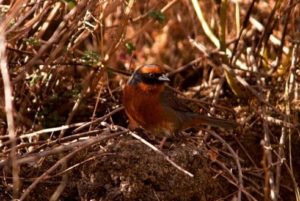
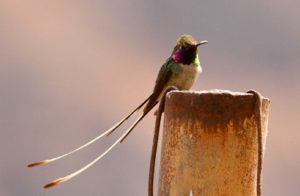
We drove back to our lodge after spending some time birding at lower elevations in the Santa Eulalia Valley. It was a great day indeed, even though the Streaked Tit-Spinetail managed to elude us. A good dinner was followed by an early bedtime to rest and get ready for the next day.
Day 3, September 16th 2019. Marcapomacocha and transfer to Concepción
Marcapomacocha and the road to Milloc area, at 4700 meters (15419 feet) above sea level between the borders of the states of Lima and Junín at the base of snow-capped mountains, is a habitat of a great set of high-elevation birds that have made the name Marcapomacocha almost legendary among birders. We had a whole morning to look for several targets, and we knew that we had to take it easy because of the high elevation. Fortunately we had good weather on our side, and the birds were very active. We started the day with views of Creamy-winged Cinclodes as well as of several Bright-rumped Yellow Finches, Black Siskin, White-winged Diuca Finch, and Plumbeous Sierra Finch.
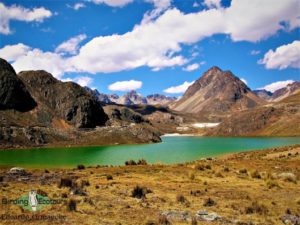
We passed the mining sector and went directly to the habitat of one of the most-wanted species in the world, Diademed Sandpiper-Plover. We explored the bog cushions of Marcapomacocha, and there it was, our Diademed Sandpiper-Plover in the scope! We also had excellent views of Olivaceous Thornbill, Ochre-naped, Cinereous, and Taczanowski’s Ground Tyrants, and a magnificent Andean Condor with two Mountain Caracaras soaring above us.
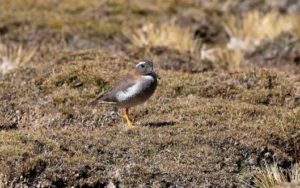
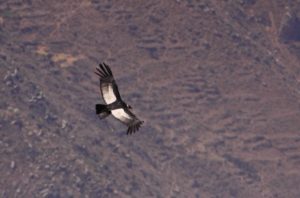
We left Marcapomacocha toward the Ticlio Pass, the highest mountain pass in the Peruvian Andes 4818 meters (15807 feet) above sea level. Before the pass we had scope views of Giant Coot and the endemic and Critically Endangered (IUCN) White-bellied Cinclodes, which performed amazingly for us. We also had a nice view of Culpeo (Andean Fox), which is the second-largest canid in South America. Birding the high pass proper we saw the endemic Dark-winged Miner, Slender-billed Miner, Buff-breasted Earthcreeper, Mountain Caracara, Andean Flicker, Andean Goose, Andean Gull, Streak-backed Canastero, and the most-wanted Rufous-bellied Seedsnipe. Then we headed toward Concepción in Junín state for an overnight.
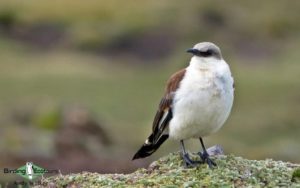
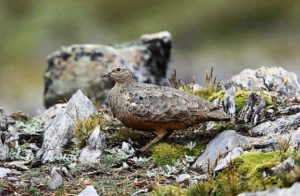
Day 4, September 18th 2019. Satipo Road (upper parts)
On this, perhaps one of the longest days of the trip, we left Concepción to bird the upper parts of the famous Satipo Road. Due to the lack of accommodation and facilities we strategically focus on the high and mid elevations of the Satipo Road on our first day here, drive all the way down to Satipo, and later focus only on the mid to low elevations of this so productive road. The upper parts of the road did not add any new species as we climbed high to 4000 meters (13123 feet) near Lake Pomacochas. We did see Andean Goose and Andean Gull, but the best was a pair of Aplomado Falcons on a rock near the road. We drove directly to Puente Carrizales, but not before we had great views of the still-undescribed “Millpo Tapaculo”. This part of the Mantaro Valley still holding at least three different taxa that still wait for scientific description, and a new species of Scytalopus, Junin Tapaculo, has been described to science recently. It took a time, but we finally found our first target, the endemic Fiery-throated Metaltail, and minutes later we had super views of the range-restricted and endemic Eye-ringed Thistletail.
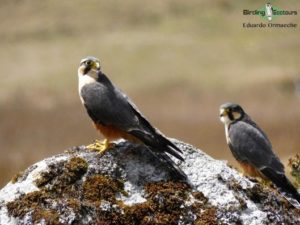
We arrived in the cloudforest and managed to find Crimson-mantled Woodpecker, Smoke-colored Pewee, Scarlet-bellied Mountain Tanager, Slaty Brushfinch, Barred Fruiteater, and the endemic Peruvian Wren. Then we started the long drive to Satipo, knowing that we would return for more.
Day 5, September 19th 2019. Apalla-Andamarca Road
Again we had a predawn start to get back to the road. Today we planned to explore the Apalla-Andamarca Road on the Mantaro Valley slope and focus on a handful of endemics and undescribed species in this remote area of Peru. We had an excellent start with birds such as the endemic Creamy-crested Spinetail, Citrine Warbler, White-winged Black Tyrant, Golden-billed Saltator, and in the same area “Mantaro Wren” and the endemic Black-spectacled Brushfinch. What a start! We continued birding the drier parts of the road until we arrived in the habitat of “Mantaro Thornbird”, which did not prove too difficult for us.
With the three top birds for this section of the valley in the bag we went back to the humid cloudforest area to add three more endemics, namely Tschudi’s Tapaculo, Junin Tapaculo, and Marcapata Spinetail. Sadly Chestnut Antpitta did not play for us. However, we found other excellent birds such as Grey-breasted Mountain Toucan, Northern Mountain Cacique, Hooded Mountain Tanager, White-banded Tyrannulet, White-throated Tyrannulet, Pearled Treerunner, Barred Fruiteater, Streaked Tuftedcheek, Mountain Wren, and Inca Jay.
Then we birded the Satipo Road again on the way back to Satipo, and we enjoyed the hoped-for Andean Cock-of-the-rock. We could have found more birds, but we had to cover some distance before getting back to Satipo. We left in good time and descended to the tropical weather of Satipo and back to our favorite restaurant, La Vaquita Loca, for a great dinner, a cold beer, and a toast to another long, great day.
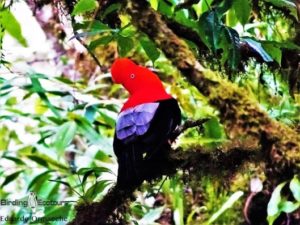
Day 6, September 20th 2019. Satipo Road (lower parts) and transfer to Oxapampa
We had another predawn start to explore the lower parts of the Satipo Road. We had a tasty breakfast made by our master chef and were ready at dawn for the birds. On the way we flushed a Pauraque off the road and then had nice views of Andean Motmot, Bluish-fronted Jacamar, Dusky-green Oropendola, a pair of Rufous-capped Nunlets, Long-tailed Tyrant, Great Kiskadee, Social Flycatcher, White-browed Antbird, Blackish Antbird (heard only), and Bay-headed, Spotted, Paradise, and Magpie Tanagers. We were searching for Amazonian Umbrellabird, but without success. Then we saw Fasciated Tiger Heron along the river. Farther up we found Blue-banded Toucanet and Versicolored Barbet, and as the morning ended we continued our journey toward Ulcumano Lodge in Oxapampa in the Pasco state.
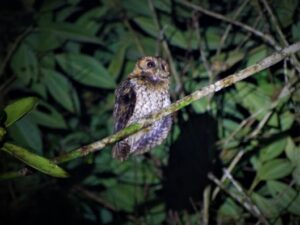
We were welcomed by our host, who after checking us into our rooms and providing us with a great dinner took us to a new site for the most-wanted species on his property, the little-known Cloud-forest Screech Owl. We scored with this owl on our first night at Ulcumano Lodge, and the next day was full of promises.
Day 7, September 21st 2019. Ulcumano Lodge
We spent the whole morning birding the lodge surroundings after enjoying an amazing breakfast. We found Tricolored Brushfinch, Striped Treehunter, Buff-browed Foliage-gleaner (heard only), and the striking White-eared Solitaire. In addition Flavescent Flycatcher, Yellow-throated Tanager were found, and our main targets were about to come. First we had great views of the endemic Rufous-vented Tapaculo followed by good views of the endemic Masked Fruiteater, Andean Motmot, Rufous-booted Racket-tail, Long-tailed Sylph, Bronzy Inca, and Chestnut-breasted Coronet. We tried hard for the endemic Bay Antpitta but had no success in the morning, as the bird was quiet. Then we had the first rain on the trip and went back to the lodge, but not before watching the splendid Chestnut-crested Cotinga in the scope. The afternoon was quiet, and we decided to give Bay Antpitta another try, but it seemed that the bird was not vocal at this time of the year around Ulcumano Lodge. We saw Red-throated Caracara, unusual at the lodge’s elevation, and then hit a flock with species such as Beryl-spangled Tanager, Yellow-throated Tanager, Mottle-cheeked Tyrannulet, Streaked Xenops, Variable Antshrike, Common Bush Tanager, and Sickle-winged Guan.
Day 8, September 22nd 2019. Bosque Fundo Armorique
We left Ulcumano and drove towards La Merced where we met our local contact who took us to the recently opened Fundo Armorique, a local coffee plantation with a huge undisturbed forest (Bosque Fundo Armorique) above on the mountains. The drive from the main road to the forest can be tricky and is possible impassable without a 4×4 during the rainy season, when it can get very muddy. Fortunately we did not have that problem and arrived rather quickly at the plantation. Our first bird was Round-tailed Manakin; we had good views of at least three males at the lek. Then we returned to the vehicle and drove near the top of the forest on the mountain. The birding was outstanding. not only did we find our main target, the endemic Creamy-bellied Antwren, which proved a bit tricky this time, but also saw unexpected species like the endemic Cerulean-capped Manakin, Rufous-breasted Wood Quail, Ocellated Piculet, Chestnut-backed Antshrike, Blue-headed Parrot, White-backed Fire-eye, Plain-winged Antshrike, Stripe-chested Antwren, White-crowned Manakin, Scale-crested Pygmy Tyrant, Streaked Xenops, and Montane Foliage-gleaner. We heard Northern White-crowned Tapaculo but did not try for it, as we were trying to catch a bigger fish, Brown Tinamou, which came closer but not close enough.
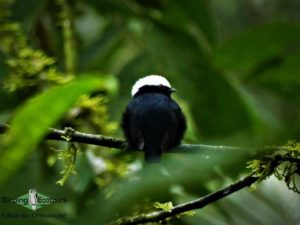
After a great session in the morning we drove back to the plantation, where there was open country and we saw common species such as Common Tody-Flycatcher, Swallow Tanager, Speckled Chachalaca, Blue-grey Tanager, Palm Tanager, White-necked Jacobin, and Black-breasted Mango.
We then left the Chanchamayo Valley and drove to Tarma, where we found ourselves trapped in a local parade with hundreds of people and a nightmare traffic jam – the worst thing you can expect after a long birding day. The noise took some time to vanish, but fortunately a nice beer helped us to get some deserved rest at the end of the day.
Day 9, September 23rd 2019. Lake Junín and drive to Huánuco
We left Tarma and drove to the shores of Lake Junín. This largest lake entirely within Peruvian territory is part of the Junín National Reserve, which is of great natural, environmental, and historical importance. To see the flightless, Critically endangered (IUCN), and endemic Junin Grebe we had to drive to Ondores and from there take a small boat across the lake to the Cazapatos sector, where a big population of the grebe still occurs. We arrived at Ondores in time to have breakfast and look for our first target, the local subspecies of Black Rail, which is considered by some authorities to be as a different species, Junin Rail. With the help of Cesar, the local boatman and bird guide in the Junín Lake area, we managed to track down this once mythical and almost impossible-to-see species. We had great looks of one individual on the tall grass at the lake edge. Another outstanding bird was a male Black-breasted Hillstar perched on a huge bolder, giving us great views. The lake was full of the classic Andean waterfowl, with species including Cinnamon Teal, Puna Teal, Yellow-billed Teal, Yellow-billed Pintail, Crested Duck, and Andean Duck. Several Andean Coots, Wilson’s Phalarope, Baird’s Sandpiper, Greater Yellowlegs, and hundreds of Chilean Flamingos provided a beautiful natural backdrop. We also managed to find a fabulous couple of Junin Grebes. Perfect! Other birds on the lake included Silvery Grebe, Andean Negrito, Andean Goose, Puna Ibis, Andean Lapwing, Andean Flicker, Black-billed Shrike-Tyrant, and Cinereous Harrier. Later we drove along the Ondores road and found at least three Puna Snipes and a Lesser Horned Owl roosting at daytime.
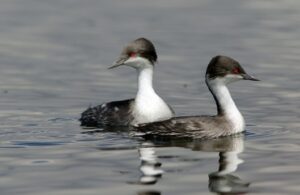
We continued our drive across the Andes until we arrived in Huánuco, the capital city of the Huánuco state, for a three-night stay. We checked into our comfortable hotel, ready for dinner and a cold beer.
Day 10, September 24th 2019. Bosque Unchog
So far, after 10 days of fun and adventure, we could boast not only about the success with our targets but also about the great weather we had during the tour. Sadly today was an exception. We left Huánuco before dawn in order to be on time at the famous Bosque Unchog elfin forest. After a couple of hours we arrived on time at Bosque Unchog for breakfast, and as soon as we had finished and were ready for our birding hike the clouds covered the sky and it really looked like rain. We had to play it by instinct and continued walking, as the rain might take some time to fall. We soon found the endemic Coppery Metaltail, Line-fronted Canastero, Red-crested Cotinga, and Moustached Flowerpiercer. Later we saw White-chinned Thistletail, and right there the rain came and did not stop except for a few minutes during the entire morning. It spoiled the birding day and the chances to score our targets. But despite the fact that we had to be careful while walking down a narrow, steep trail we did well and managed to get to our usual site for the endemic Golden-backed Mountain Tanager, which, however, couldn’t be found. We waited for a while until the rain stopped for a few minutes, which gave us some bird activity. We found a flock with White-banded Tyrannulet, White-throated Tyrannulet, Pearled Treerunner, Hooded Mountain Tanager, Chestnut-bellied Mountain Tanager, Yellow-scarfed Tanager, and Golden-collared Tanager. All these birds passed very fast, and it was difficult to follow them through the low canopy of the elfin forest. After some minutes, though, we had great views of the endemic Bay-vented Cotinga perched in front of us. Then another good species showed up nicely, Pardusco. We waited for a few hours, but there was no sign for the weather to get better; in fact it got worse, so we decided to start the hike back to the car. Before we left the site we had splendid views of the endemic Neblina Tapaculo.
Before we arrived at the little community of Cochabamba located below Bosque Unchog we found another endemic, the range-restricted Brown-flanked Tanager. On the way to the main road we crossed the dry section of the valley, a suitable habitat for the endemic Spot-throated Hummingbird, which we saw right away. Other birds included Pacific Pygmy Owl, Fasciated Wren, and White-bellied Hummingbird.
Another day had passed, and we were ready for another delicious dinner and a good checklist session. Over dinner we decided to skip our extra day at Bosque Unchog and switch it to another locality. It was a hard decision for everybody, but it would have been difficult to repeat the hike on another rainy day, and the forecast was showing rain for the Huánuco area again. So we decided to do the best for the group’s safety and enjoyment, and I came with a good option for the next day, namely a morning in the tropical lowlands of Tingo Maria to look for Blue-headed Macaw, which was on the wish list of the participants but had not been expected to be found on the tour.
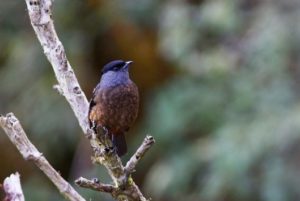
Day 11, September 25th 2019. Tingo Maria and Villa Jennifer Lodge
We had another predawn start, drove to Tingo Maria, and arrived at the entrance of the Tingo Maria National Park, where we stopped and started to scan the forest clearing, canopy, and river looking for the macaw. We saw flocks of White-eyed Parakeets, White-winged Swallow, White-banded Swallow, Southern Rough-winged Swallow, and Blue-grey Tanager and a glimpse of Blue-headed Macaw silhouetted in the sky. Well, not good enough! We explored some areas away from the main road, following the Monzón and Huallaga Rivers. We found Swallow-winged Puffbird, Black-capped Donacobius, and Hoatzin, but no trace of the macaw. So we decided to return to the entrance of Tingo Maria National Park, where we finally found a couple of Blue-headed Macaws perched in a tree and giving exquisite scope views.
Then we went to bird the Villa Jennifer Lodge, where we were able to add more species to our day list, including Bluish-fronted Jacamar, the endemic Huallaga Tanager, Ringed Kingfisher, Amazon Kingfisher, Bat Falcon, Orange-backed Troupial, Golden-tailed Sapphire, Chestnut-eared Aracari, Grey-capped Flycatcher, and the silhouettes of Military Macaws.
After lunch in the lodge we drove back to Huánuco with a stop at the Carpish Tunnel. Once one of our favorite birding spots, the habitat now is dramatically disappearing due to large-scale deforestation and the introduction of Hortensia (Hydrangea macrophylla) for commercial purposes. We made a brief stop at the tunnel to add Violet-throated Starfrontlet and Amethyst-throated Sunangel, and back at our hotel in Huánuco we celebrated another good birding day.
Day 12, September 26th 2019. Kotosh and drive to La Oroya
The original plan for today had been a day of travel between Huánuco and La Oroya with some birding along the way. But was there was nothing new left for the group to see, except one country endemic, Junin Canastero, so we decided to have a late start, to enjoy the hotel breakfast, and before hitting the road to make a short visit to the pre-Hispanic site of Kotosh, five kilometers from the city of Huánuco. The Temple of the Crossed Hands is one of the oldest ancient religious archaeological sites in the Americas, around 4,000 years old. The visit was an interesting and educational experience. There were not many birds at the site except for a few Fasciated Wrens and Blue-and-white Swallows.
After a short visit we found ourselves getting out of bustling Huánuco and hitting the road again. We made a stop outside Huánuco, and, although it took a while, we found Rufous-backed Inca Finch. Then we drove along the Polylepis forest of La Quinua but we did not stop, as we had birded the Huascarán National Park in 2012, finding all the Polylepis specialists except one, which was left for the very last day of this tour. We started climbing, and a couple of hours later we were back at 4000 meters (13123 feet) in the Junín plains. It was nice to see troops of wild Vicuñas; this amazing animal is recovering from its once very endangered existence. We looked for a good spot that would allow our driver and master chef to prepare some tasty soup while we were determined to find our target. And after a few minutes there it was, the endemic Junin Canastero. With the canastero in the bag we made our way back to La Oroya. Sleeping at 3800 meters (12467 feet) is not an easy task, but the new hotel in town is so comfortable that we had a good night’s sleep to get ready for our last birding day in the Central Andes.

Day 13, September 27th 2019. Polylepis Forest and transfer back to Lima
We had another early start to leave La Oroya on the route to Marcapomacocha, then to the detour to Milloc, and then we connected with the Santa Eulalia road once more. In the upper parts of the Santa Eulalia Valley at 3700 meters (12139 feet) there is a patch of Polylepis forest called Japaní. This has been a reliable site for the endemic and most-wanted White-cheeked Cotinga for some years, and we were determined to get it after having missed it in 2012. We arrived at the site before 8 a.m. in time for coffee, set up the scope, and started to look for our target. By the road we found the endemic Rusty-crowned Tit-Spinetail, Mourning Sierra Finch, Peruvian Sierra Finch, and Rufous-collared Sparrow. We also had superb views of the endemic Black Metaltail, D’Orbigny’s Chat-Tyrant, and finally of our target, the exquisite White-cheeked Cotinga. Mission accomplished!
We continued driving the Santa Eulalia road and finding old friends like White-capped Dipper, Torrent Duck, and Great Inca Finch. Sadly we could not find Streaked Tit-Spinetail this time, but we had lots to be happy about and continued the drive to the crazy city of Lima. We arrived at our hotel in the afternoon and went immediately to get a light late lunch, which was perfect for us. Then we said our fairwells, carrying wonderful memories and a huge list of Peruvian endemics.
Day 14, September 28th 2019. Transfer to the airport for departure
The group was met by our private shuttle and transferred to the airport.
Please see the downloadable PDF above for the full species lists. This is a sample trip report. Please email us ([email protected]) for more trip reports from this destination.
‘Birding Peru for the first time in July 2012 with Eduardo, a professional and very knowledgeable local Peru guide, ensured a smooth, safe and hassle-free trip filled with south Peruvian endemics such as Junin Canastero, White-bellied Cinclodes, Great Inca-Finch and Inca Wren. Eduardo was quick to spot birds and ensured that all in the group got onto the birds as fast as possible. While birding, Eduardo also enlightened and amused us with his vast knowledge of birds and other fauna of the area. At the end of each day Eduardo assisted the group to complete a list of birds seen and heard for the day. A briefing each evening prepared participants on what to expect the next day. The accommodation was clean and safe, even in off-the-beaten-track areas. I can highly recommend the Birding Ecotours bird guide in Peru.’
Lisl

